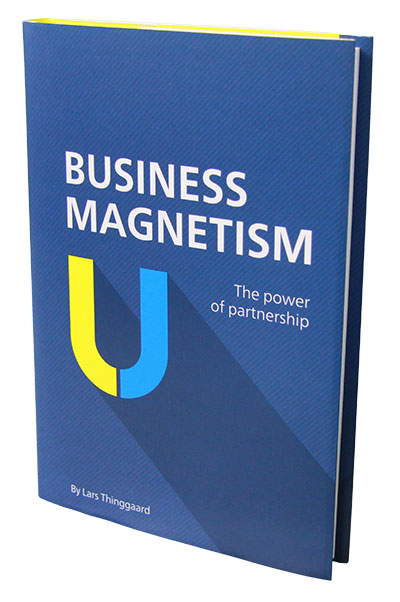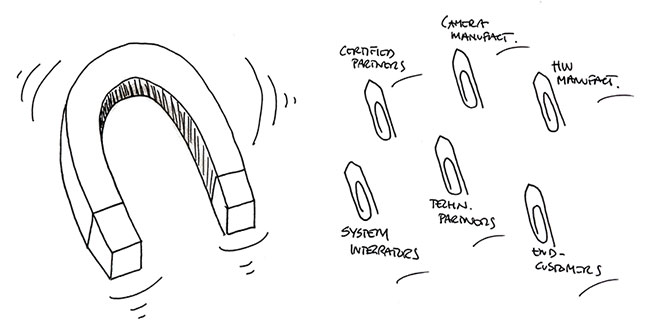
The Magnetic Center
Milestone Systems was extremely successful at taking ideas which seemed like sound concepts and putting them into practice. The key was doing it in a way that was scalable - without detrimental short-term effects.
Take, for example, the evolution of our software into a truly open platform product. This centered on the development of an API – an Application Programming Interface and an official software development kit, or SDK.
In the U.S., we actually began selling the concept of our software as an integration platform before either an API or SDK existed. It was a bold move, but we knew our software engineers were up to the task. As we expanded, I continued our founders’ strategy of employing smart, creative people to strengthen the business.
One of the first partnerships we developed was with a scrap metal yard that was a frequent victim of fraud.
 The solution we developed integrated their ATM system with Milestone’s video surveillance software, called XProtect to link video footage of customers with their transaction records, so that any impropriety could be spotted. This wasn’t a traditional ‘physical security’ use of surveillance cameras — monitoring potential intruders – it was a fully integrated part of a business system. This was then extended to include perimeter surveillance of scrap yard premises to see if people were trying to steal the scrap to re-sell.
The solution we developed integrated their ATM system with Milestone’s video surveillance software, called XProtect to link video footage of customers with their transaction records, so that any impropriety could be spotted. This wasn’t a traditional ‘physical security’ use of surveillance cameras — monitoring potential intruders – it was a fully integrated part of a business system. This was then extended to include perimeter surveillance of scrap yard premises to see if people were trying to steal the scrap to re-sell.
The partner, Transact, went on to develop a product called Scrap Dragon, which is based on the Milestone Integration Platform. Scrap Dragon was sold to scrap yards in every state of the U.S. It was a huge success, and obvious evidence of the benefits of working more on ways in which we could integrate our software with others.
Dynamic Synergies
Around this time, at global headquarters in Copenhagen, we were working with end user customers including internationally renowned retailers. By making sure their business systems benefited from a seamless integration with our software, we were able to demonstrate a significant and rapid return on investment. The outlay for the integrated system was quickly recovered through the savings made, and thefts or mistakes were also prevented.
Demonstrating return on investment with a purely physical security system has been a stumbling block for the security industry. Convincing those who hold the purse strings to dedicate part of their budget to a defensive investment – one which does not show obvious contribution to business profit or growth – can be difficult. Because of this, physical security can be treated as a ‘grudge purchase,’ and those without a real understanding of the benefits of a sophisticated system would often prefer to go for the cheapest possible option while still meeting their obligations to their insurers.
In these integration cases, however, there was a clear financial benefit to the system user. The benefit was a direct result of the way we were able to integrate our software with that of others. This tied into our philosophy of openness in action, and we wanted to explore it further.
Making the Private Public
Milestone garnered significant coverage in the industry press on the projects we were allowed to publicize. We could feel the impetus growing.
Up to this point, we had done the integration work ourselves. The significant difference with the Transact scrap yard integration was that we allowed them to do the integration on the API themselves. In this way we had indirectly enabled our first third-party vendor.
Shortly after, we realized that if we really wanted the API we were developing to become widely distributed, we should just give it away for free. Users could sign a non-disclosure agreement, and start building the necessary business infrastructure around it.
We decided the future was in making integration to our software as widely available as possible. It meant that companies who were specialists in their fields could concentrate on their strengths, and use our software’s centralized system position to broaden their customer base. We would train people in integrating their products with our software, and we would train users and installers in our software. In fact, we would make that training – certification – a requirement in our business model.
Milestone would become an enabler. An educator. An innovator. A connector.
The Power of Partnership
This idea quickly gained traction. We may not have been the first to think of it – but in the physical security world we were the first to properly put it into practice, and to make it work. There’s no point in having a wonderful concept if it doesn’t make sound business sense in the real world. We believed that letting people work with our API would not only produce more innovative applications, it would allow our engineers to develop our core products further, and to provide specialized assistance to our partners.
In 2005 we decided to have a Milestone Developers Forum in the U.S. the following year. Today, what is called MIPS – Milestone Integration Platform Symposium – began as the Milestone Developers’ Forum. At the very first event, Transact Payment Systems presented their integration. It was crucial to us that in this environment, in front of a wide variety of developers, Milestone software was presented as a viable and powerful integration platform.
We started to draw the industry together around our open platform through the power of partnerships. It was a business concept that a large number of customers valued and that we were able to scale up to reach a broader market through our partner events. Milestone started emerging as a leader in the industry. As the ecosystem expanded, our challenge was to make sure we could meet the market demand we were stimulating.
Truly Open Platform
When we saw third parties making profits by integrating their solutions to our platform, it was tempting to think that we should do it ourselves and bring it to market. But by positioning Milestone as an open platform that does the video recording, it enables all the others to specialize in their own fields of expertise, and the overall solution becomes even stronger. The more we can enable our partners, the more profitable they will become, and the more profitable we become as a result.
Around 2008, many other companies in the physical security business had noticed the success we were achieving, and started describing themselves as being ‘open platform’ or ‘open integration’ companies. Some of our partners started wondering if we should look at other ways of differentiating ourselves to the industry.
But we held fast, because the company founders and I were united in our vision of what Milestone should be. We are a truly open platform. So much so, that we decided to define the essential aspects of being an open platform, and added a tagline to our logo that reads: Milestone Systems – the open platform company.
We believe the five hallmarks of a truly open platform company are:
- Use and availability of common external programming interfaces, such as APIs;
- Published documentation such as a Software Development Kit (SDK);
- Availability of training for programmers on how to use the API;
- Availability of project consulting; and
- Walking the talk (doing what you say; living by your word).
The Magnetic Center
Alongside our unique approach to training and certification, Milestone began to function as what I would call the ‘magnetic center’ or core of a universe inhabited by all of our different partners. This is the inclusive ecosystem, which thrives with Milestone as its environment.
The real value of what we bring, in sheer monetary terms, is as an enabler – a multiplier. When you look at a video management system as part of a larger physical security system installation, Milestone software, including camera licenses, amounts to a smaller percentage of the total cost. But our impact and value is on a much larger scale.
In terms of the combined value of all the other parts of a physical security system– cameras, servers, video analytics software – we are enabling much more than our revenue, because much of the system is hardware with a higher fixed price. We do not go direct to the market – our software, and all the other elements of the physical security system, is sold through distributors to integrators and installers, who then sell the final solutions to the end customers.
Our ongoing success amounts to a ‘win-win-win’ scenario for all involved; distributors of our software, who sell more products, and are involved in more projects; manufacturer partners, who are able to integrate their products with ours, and access an increased number of projects and work seamlessly with products from other specialist manufacturers; physical security systems integrators and installers, who are confident in our software’s performance and its integration capabilities, and ease of installation; and physical security system users, who benefit from the increased functionality that our partners offer, the power and ease of use in our video management interface, and our dedicated levels of service.

When you look at Milestone’s universe, at all the people who benefit from our success, I no longer see us as a company employing 450 people. I see it as a 10,000 person organization, including all those who work with us and are affected by the decisions we make. This is what I call our “virtual organization.” Because we’re the magnetic center of this universe, our decisions can have a real impact on other companies and individuals. We need to ensure that our performance continues to benefit all those who work with us.
This way of looking at business is key to understanding the importance of leadership. It’s all very well to say that you’re looking out for the best interests of your business and your shareholders or stakeholders. But to make sure that success has longevity, you need to step back and look at all the partners you can affect, and to take steps to ensure that your decision-making is focused on the sustainability of that success. You need to build for the future, and to do so, you have to take a strategic view of the market you are in.